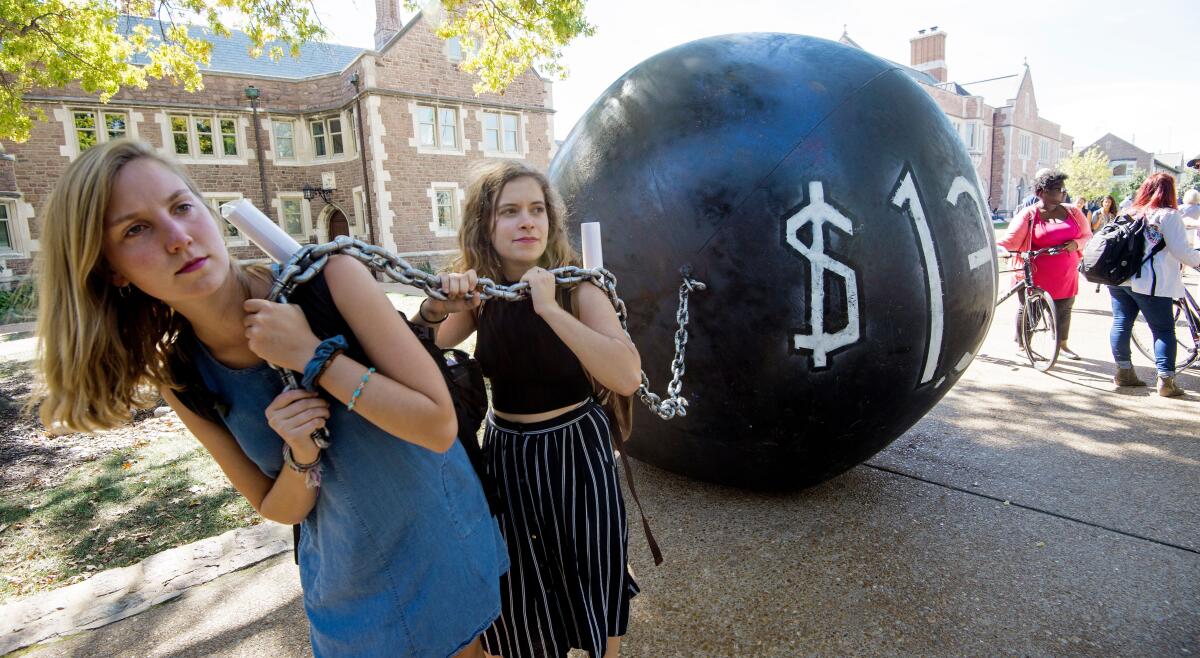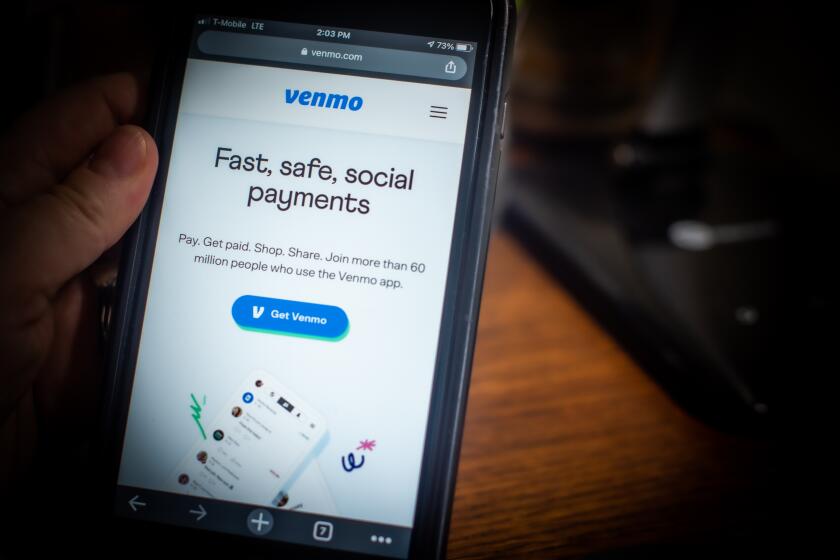Scammers have seized on student loan forgiveness. Here’s how to avoid them

- Share via
The federal government moves at the pace of cold molasses, so you shouldn’t be surprised that the U.S. Department of Education has yet to reveal how to apply for the student loan debt relief it promised in August.
But you still need to be patient because anyone offering to help you apply now could be a scammer.
Kevin Roundy, senior technical director of the internet security company NortonLifeLock in Culver City, said he has seen multiple scams directed at borrowers searching online for guidance on loan forgiveness. The goal, he said, is to get you to sign up for a service that’s going to cost you money — or refinance your debt into a new, privately issued student loan.
For example, he said, some will direct you to a site that tries to persuade you not to follow the advice of your student loan servicer. The site will claim that the servicer will give you bad terms, but “we’ll give you the best terms,” Roundy said. Or they’ll offer to take your debt forgiveness application straight to the Education Department, bypassing your loan servicer.
But the reality is this: There is no better deal, and you will be able apply directly to the department on your own.
“They’re trying to make it sound like they’re cutting out the middleman,” Roundy said, when in fact they are trying to insert themselves as the middleman.
Some try to get you on the phone, where they’ll promise lower monthly payments if you refinance your student loans through their chosen lender, Roundy said. But privately issued loans aren’t eligible for the debt forgiveness announced in August, or for any of the other borrower-friendly options offered by the federal government.
The Biden administration’s student loan relief plan is expected to wipe out the debt of 1 million or more Californians. Here’s who is eligible and for how much forgiveness.
The more people who visit the scammers’ sites, the higher they’ll appear in online search results, which in turn draws more people to them.
Roundy said he’s visited several of these sites, and although he hasn’t seen any that mimic the Education Department’s studentaid.gov site, they still look very professional. “Unfortunately, one of the problems we have ... [is] if we see a site that looks really slick, we think, ‘Oh, this has to be legitimate,’” he said.
Online reviews of the sites show that “people realize pretty quickly that they’ve been scammed,” Roundy said. Nevertheless, they “have a hard time getting their money back.”
On its student loan portal, the Education Department warns that scammers may try to lure you in by claiming that time is running out to obtain loan forgiveness. Other come-ons convey a similar sense of urgency, the department says, including: “Your student loans may qualify for complete discharge. Enrollments are first come, first served,” and “Student alerts: Your student loan is flagged for forgiveness pending verification. Call now!”
This kind of tone is a sure sign of a scam, the department says. Another dead giveaway is when someone asks you for money up front or on a recurring monthly basis in exchange for total debt cancellation, the department says.
A third red flag is when a site asks for your Federal Student Aid username and password. The Education Department “and its partners will never ask for your FSA ID password. That’s a guarantee,” the department’s website says.
Did someone send you money ‘by accident’ on Venmo, Zelle or Cashapp? Don’t rush to send it back. Here’s what to do.
To avoid getting suckered, here are a few more things to remember.
1. There is no rush to apply. The Education Department is expected to make the application forms available online in October, and you can sign up to be notified by email when the forms are available. You’ll need to have an account at studentaid.gov, but you should have one regardless — you’ll need it to make sure your contact information and payment history are correct.
By the way, the department has said that borrowers who meet the annual income limits (no more than $125,000 for a single individual or $250,000 for a couple) will qualify automatically for loan forgiveness if it already has their income information. So if you’ve been filing annual income statements as part of an income-driven repayment plan, you shouldn’t have to file any forms to receive the loan forgiveness announced in August.
President Biden’s loan forgiveness plan papered over some of the financial aid complexities. Here’s how to figure out if your loan may be eligible.
2. You don’t need to pay anyone to obtain the promised loan forgiveness. There will be no fees involved, and the department says the form (if you need to apply) will be simple to fill out. Anyone who offers to help you for a fee is trying to take advantage of you.
Granted, your situation may be complicated — for example, you may have several different types of student loans, and if your parents still claim you as a dependent, their income, not yours, will determine your eligibility. But you should be able to navigate this by following the instructions laid out on studentaid.gov.
3. Be wary of anyone asking for sensitive financial information. Scammers can’t gain access to your student loan information or your bank account unless you give it to them. So don’t. And if a site claiming to be an official government agency is asking for this information, check its web address carefully — it may be a slightly altered version of the real thing.
4. No one can make all your debt go away immediately. A common pitch from scammers is a promise of immediate and total debt forgiveness. It’s an offer they can’t fulfill.
The federal government has a number of programs that can forgive debt after 10 to 25 years of monthly payments, but those are hardly instantaneous. The new blanket forgiveness, meanwhile, is capped at $10,000 (or $20,000 for borrowers who received Pell Grants), which is less than many borrowers owe. (And that plan is being challenged in court.) So instant, total debt relief is an offer too good to be true.
Criminals have been using social media to help target victims for years. Here are some practical steps you can take to avoid hazards as you share your experiences online.
5. You may need to consider your state tax bill. At the moment, the amount of debt forgiven under Biden’s blanket plan would be taxable as income by California. The state’s two top lawmakers have promised to pass a legislative fix by the time taxes are due in April.
6. If you are scammed, you can limit the damage. The Education Department advises people who realize they’ve been conned to talk to the company servicing their federal student loans as soon as possible to block or revoke any changes.
Other steps recommended by the department include stopping all payments to the scammer by your bank or credit card company and filing a complaint with the department, the federal Consumer Financial Protection Bureau and the Federal Trade Commission.
About The Times Utility Journalism Team
This article is from The Times’ Utility Journalism Team. Our mission is to be essential to the lives of Southern Californians by publishing information that solves problems, answers questions and helps with decision making. We serve audiences in and around Los Angeles — including current Times subscribers and diverse communities that haven’t historically had their needs met by our coverage.
How can we be useful to you and your community? Email utility (at) latimes.com or one of our journalists: Jon Healey, Ada Tseng, Jessica Roy and Karen Garcia.
More to Read
Sign up for Essential California
The most important California stories and recommendations in your inbox every morning.
You may occasionally receive promotional content from the Los Angeles Times.















